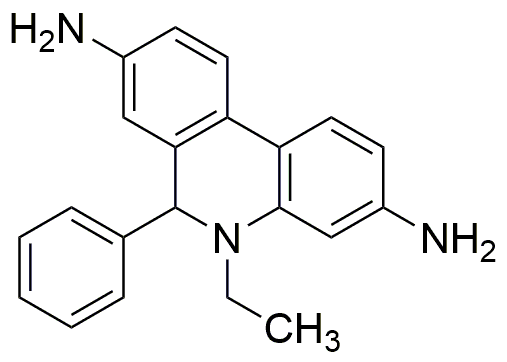Dihydroethidium is widely utilized in research focused on:
- Cellular Imaging: This compound is frequently used as a fluorescent probe to visualize reactive oxygen species (ROS) in live cells, helping researchers study oxidative stress and its implications in various diseases.
- Neuroscience Research: Dihydroethidium is employed to investigate neurodegenerative conditions by tracking oxidative damage in neuronal cells, providing insights into potential therapeutic targets.
- Cardiovascular Studies: In cardiology, it aids in assessing oxidative stress in heart tissues, allowing for a better understanding of heart diseases and the development of antioxidant therapies.
- Drug Development: The compound is used in pharmacological studies to evaluate the efficacy of new drugs aimed at reducing oxidative stress, which is linked to numerous health issues.
- Environmental Monitoring: Dihydroethidium can be applied in studies assessing the impact of pollutants on cellular health, providing valuable data for environmental research and public health initiatives.
Información general
Propiedades
Seguridad y normativas
Aplicaciones
Dihydroethidium is widely utilized in research focused on:
- Cellular Imaging: This compound is frequently used as a fluorescent probe to visualize reactive oxygen species (ROS) in live cells, helping researchers study oxidative stress and its implications in various diseases.
- Neuroscience Research: Dihydroethidium is employed to investigate neurodegenerative conditions by tracking oxidative damage in neuronal cells, providing insights into potential therapeutic targets.
- Cardiovascular Studies: In cardiology, it aids in assessing oxidative stress in heart tissues, allowing for a better understanding of heart diseases and the development of antioxidant therapies.
- Drug Development: The compound is used in pharmacological studies to evaluate the efficacy of new drugs aimed at reducing oxidative stress, which is linked to numerous health issues.
- Environmental Monitoring: Dihydroethidium can be applied in studies assessing the impact of pollutants on cellular health, providing valuable data for environmental research and public health initiatives.
Documentos
Hojas de datos de seguridad (HDS)
La SDS proporciona información de seguridad completa sobre la manipulación, el almacenamiento y la eliminación del producto.
Especificación del producto (PS)
La PS proporciona un desglose completo de las propiedades del producto, incluida la composición química, el estado físico, la pureza y los requisitos de almacenamiento. También detalla los rangos de calidad aceptables y las aplicaciones previstas del producto.
Certificados de análisis (COA)
Busque certificados de análisis (COA) ingresando el número de lote del producto. Los números de lote y de partida se pueden encontrar en la etiqueta de un producto después de las palabras "Lote" o "Lote".
Número de catálogo
Número de lote/lote
Certificados de origen (COO)
Este certificado de origen confirma el país en el que se fabricó el producto y también detalla los materiales y componentes utilizados en él y si se deriva de fuentes naturales, sintéticas u otras fuentes específicas. Este certificado puede ser necesario para cumplir con las normativas aduaneras, comerciales y regulatorias.
Número de catálogo
Número de lote/lote
Hojas de datos de seguridad (HDS)
La SDS proporciona información de seguridad completa sobre la manipulación, el almacenamiento y la eliminación del producto.
DownloadEspecificación del producto (PS)
La PS proporciona un desglose completo de las propiedades del producto, incluida la composición química, el estado físico, la pureza y los requisitos de almacenamiento. También detalla los rangos de calidad aceptables y las aplicaciones previstas del producto.
DownloadCertificados de análisis (COA)
Busque certificados de análisis (COA) ingresando el número de lote del producto. Los números de lote y de partida se pueden encontrar en la etiqueta de un producto después de las palabras "Lote" o "Lote".
Número de catálogo
Número de lote/lote
Certificados de origen (COO)
Este certificado de origen confirma el país en el que se fabricó el producto y también detalla los materiales y componentes utilizados en él y si se deriva de fuentes naturales, sintéticas u otras fuentes específicas. Este certificado puede ser necesario para cumplir con las normativas aduaneras, comerciales y regulatorias.


